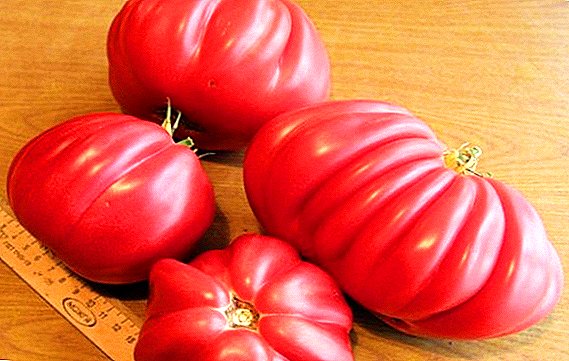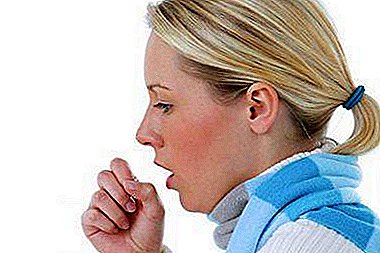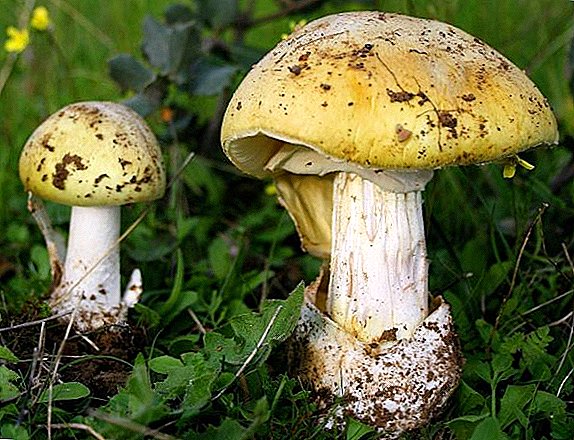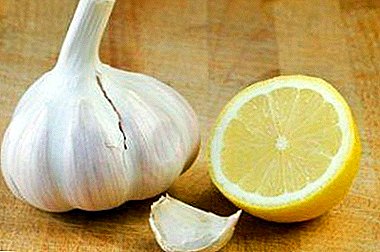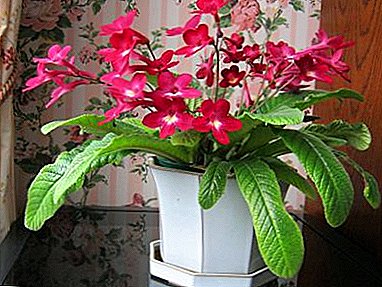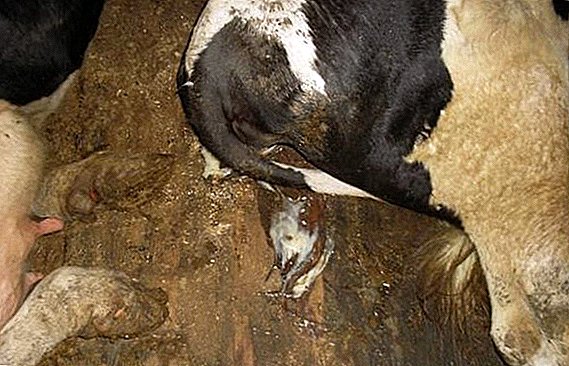 Complications after childbirth are a frequent occurrence not only in women, but also in animals. The main problem in the treatment of inflammatory processes in the uterus of the latter is the difficulty of diagnosing the stage of the disease and the selection of necessary drugs, respectively. In this article, we will tell you about cattle endometritis, after which complications can cause a serious blow to the reproductive system of cows.
Complications after childbirth are a frequent occurrence not only in women, but also in animals. The main problem in the treatment of inflammatory processes in the uterus of the latter is the difficulty of diagnosing the stage of the disease and the selection of necessary drugs, respectively. In this article, we will tell you about cattle endometritis, after which complications can cause a serious blow to the reproductive system of cows.
What kind of disease - endometritis in cows
This is called inflammation in the inner mucous membrane of the uterus of a cow. The main danger of this disease is the difficulty of diagnosing the early stage of endometritis, which very quickly develops into a chronic form and is difficult to further treatment. It can provoke other pathologies in the work of the organs of the reproductive system in cows, and also cause their infertility.
Important! The use of antibiotics and certain hormonal drugs in the treatment of endometritis makes the meat and milk of cows unsuitable for consumption.
Causes
As a rule, veterinarians diagnose endometritis in cows due to:
- Non-observance by the veterinarian of sanitary and hygienic norms during calving. This is one of the most common causes of inflammation in the tissues of the uterus. Insufficient purity of tools and carelessness of obstetricians contributes to the rapid penetration of bacteria into the internal organs of the cow;
- Uterine injuries in the process of obstetrics (for example, stretching or falling out), abortions, as well as violations during the procedure of separation of the afterbirth;
- Diseases of cattle, provoking inflammatory processes in animal tissues, including the uterus (brucellosis, salmonellosis, leptospirosis);
- Monotonous nutrition and lack of necessary vitamin-mineral complexes in the animals ’diet;
- General sanitation in the barn;

Vaccination of cattle will help to avoid such serious diseases as brucellosis, leptospirosis, rabies, foot and mouth disease.
Types and symptoms of endometritis
Veterinarians distinguish several types of endometritis in cattle, each stage has its own characteristic symptoms, the appearance of which should alert every farmer. Let's tell about them in more detail.
Catarrhal
This stage is also called postpartum endometritis. It occurs immediately after calving and is difficult to determine due to similar changes in the uterus of the cow.  Symptoms are as follows:
Symptoms are as follows:
- vaginal discharge from the cow with mucus;
- unpleasant smell of lohius;
- termination or sharp decrease in lochia secreted;
- rarely, decreased appetite and elevated body temperature in an animal.
Did you know? Scientists have proven that cows have a fairly good intelligence - they are able to remember their name, recognize their owner in the crowd, and also use various types of lowing to communicate with other animals.
Purulent catarral
This is the next stage of the inflammatory process in the tissues of the uterus of the cow. The following symptoms are added to signs of catarrhal endometritis:
- the color lohy becomes gray, yellow or dark brown;
- vaginal discharge with admixture of pus;
- heat;
- decreased appetite;
- decrease in milk yield;
- an internal examination of the uterus, it becomes noticeable swelling and flabbiness of its walls;
- the animal becomes lethargic and looks sick.
Check out common infectious and non-infectious diseases in cattle.
Acute fibronous
If an animal has a strong immune system, then the fibronous form of endometritis takes place in a mild form - cow leukocytes do not allow microbes to penetrate into the uterus, thereby enhancing inflammatory processes.  In the initial stages of fibrinous endometritis, the cow feels good. Acute fibronous endometritis can be determined by the following features:
In the initial stages of fibrinous endometritis, the cow feels good. Acute fibronous endometritis can be determined by the following features:
- in lochia, fibrins are clearly visible, which are in the form of fine fibers or clots of red and brown color;
- heat;
- the cow looks dull and oppressed;
- frequent heartbeat;
Necrotic
At this stage of endometritis, inflammation of the uterus of the cow begins. Inside it, ulcers and scars begin to form - a weakened animal body tries to reject the nidus with the infection. In the absence of timely treatment, the infection enters the bloodstream and spreads throughout the body, thereby causing severe intoxication.  Symptoms of this stage are as follows:
Symptoms of this stage are as follows:
- heat;
- lack of appetite;
- empty udder;
- the cow stands hunched over;
- frequent heartbeat;
- discharge red or brown with admixture of gruel.
Important! Massage is one of the main ways to reduce the swelling of the uterus during illness. However, it is forbidden to do it in the case of diagnosing necrotic and gangrenous-septic stages. The walls of the uterus can rupture and pus and bacteria spread throughout the body of the animal.
Gangrenous septic
This is the most severe type of endometritis, which often ends with the death of the animal. At this stage, the inflammatory processes are almost irreversible - bacteria poison the blood, causing severe intoxication of the body, and the uterus of the cow is destroyed.  A sick cow does not eat or give milk. This stage of endometritis can be diagnosed by the following features:
A sick cow does not eat or give milk. This stage of endometritis can be diagnosed by the following features:
- purulent discharge;
- high temperature (40-41 ° С);
- the cow’s perineum and perineum acquire a putrid odor;
- external genitalia are edematous;
- the animal often and superficially breathes;
- heart palpitations;
- milk is absent;
- no appetite;
- the cow assumes a lying position and practically does not get up on its feet.
The reason for the decline in milk production of cows can also be a disease of the udder.
Diagnostics
Timely diagnosis of any disease significantly increases the chances of the animal to recover. After calving (especially with complications), it is important to regularly conduct an external examination of the reproductive organs of the cows, as well as rectal palpation of the uterus.  The rudiments of inflammatory processes can be quickly and effectively detected by histological examination of tissue samples taken from the vagina of a cow.
The rudiments of inflammatory processes can be quickly and effectively detected by histological examination of tissue samples taken from the vagina of a cow.
Did you know? In many nations of the world, before the advent of paper money, cows were used as currency. The more cows requested in the market for any product, the higher was its value.
Treatment of endometritis in cows
In case of detection of inflammatory processes in the uterus, animals are separated from the rest of the herd and sent to quarantine for further observation. If there are several diseased cows - the veterinarian assesses the severity of the inflammatory process of each cow separately.
Immunity strengthening
It is not a secret for anyone that the stronger the protective forces of an animal, the faster its recovery, and the disease itself proceeds much easier and without complications. To strengthen the immune system of cows suffering from endometritis, various complex vitamin supplements are added to their diet. In general therapy, preparations based on fish oil, potassium iodine, and calcium chloride are used. In the second half of pregnancy, microelements are added to the cows in their daily diet - zinc, copper, cobalt and manganese. 
Antibiotics
To destroy pathogenic microflora in the tissues of the uterus, veterinarians use anti-inflammatory drugs and antibiotics. In veterinary pharmacies, you can purchase a large number of drugs that are well recommended in the treatment of inflammatory processes in the tissues of the uterus.
- Rifapol. This drug based on rifampicin and polymyxin is available in suspension. The treatment regimen of rifapol is as follows: 200-300 ml every 48 hours. The drug is injected directly into the uterine cavity. The course of treatment consists of 2-3 injections;
- Metrin. The drug is introduced into the uterine cavity. The dose of the drug is calculated as follows - 30 cu. cm per 100 kg of animal weight, the interval between administration is 48-72 hours. The course of treatment consists of 2-3 injections;
- Streptomycin. The drug is administered intramuscularly. The treatment regimen is 2 g every 48 hours, the number of injections is 5 (in severe cases it is 7);
- Bicillin-5. The drug is administered intramuscularly, a single dose of 3 million units. The interval between injections is 48 hours, the duration of the course is 5 injections;
- Lexoflon Introduced intramuscularly, the dose is calculated based on the weight of the animal - 1 ml. on 30 kg. weight. The interval between injections is 24 hours, the course of treatment is 3-5 days;
- Kanapen Bel. The drug is introduced into the uterine cavity. Single dose - 10 ml. Injections are made every 48 hours, the number of injections - 5.

Prevention
Conducting preventive measures significantly reduce the likelihood of the formation of postpartum inflammatory foci in the uterine cavity of a cow. We invite you to find out what exactly this concept includes:
- Competently organized delivery process. The use of sterile instruments, disposable gloves and cleanliness in the barn reduces to zero the probability of damage to the internal genital organs of the animal by pathogenic microorganisms. Not the last role in this important matter is the qualification and experience of the veterinarian. The ideal would be the construction of separate rooms for a calving in which childbirth will take place and further observation by farm workers;
- Timely administration of antimicrobial drugs. This preventive measure will not allow microbes to multiply in the tissues of the uterus if they get inside the body. Additionally, oxytocin is introduced, which helps the muscles contract, and hormonal preparations that accelerate the restoration of the reproductive system of cows;
- Balanced and varied diet throughout the pregnancy and after calving. Particular attention should be paid to the constant access of animals to clean water;
- Regular disinfection of the premises, replacement of bedding, cleaning of water bowls and other equipment in the barn.

Reviews
if during estrus endometritis, then intrauterine can be gentamicin sulfate 4% 10 -15 ml through a polystyrene pipette. (as cows are inseminated by the rectocervical method.) just the neck is opened and gentomicin is injected instead of the seed, and in a subsequent hunt if there is no purulent discharge, it is inseminated.



